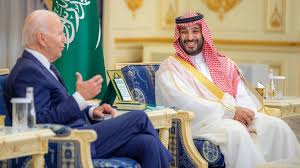19 November 2025 Indian Express Editorial
What to Read in Indian Express (Topic and Syllabus wise)
Editorial 1 : US–Saudi Relations and the Centrality of Israel in Middle East Geopolitics
Context:
Saudi Crown Prince Mohammed bin Salman’s (MbS) visit to Washington indicates a major shift in US–Saudi relations, with Israel emerging as the key strategic variable shaping the regional order.
Introduction
The visit by Saudi Crown Prince Mohammed bin Salman to the United States represents an important moment in Middle Eastern geopolitics. It signals a recalibration of the US–Saudi partnership, renewed strategic bargaining, and a potential reordering of regional alignments, particularly around Israel and Iran.
Key Developments in US–Saudi Relations
- Historical Shifts
- The US–Saudi partnership, built during the Roosevelt–Ibn Saud meeting (1945), was traditionally rooted in oil and regional security cooperation.
- Recent years have seen divergence: US focus on Asia, energy self-sufficiency, human-rights concerns, and Saudi diversification under Vision 2030.
- MbS’s Priorities
- Securing US support for internal political succession.
- Attracting American investment and technology for Vision 2030, including AI, defence manufacturing, logistics, and nuclear energy.
- Enhancing Saudi Arabia’s role as a global economic hub.
- Technology and Defence Cooperation
- Saudi aims for access to advanced US weapons systems (like F-35) and defence co-production.
- Greater AI-driven partnerships, data-centre investments, and frontier research cooperation.
The Centrality of Israel
- US Push for Saudi–Israel Normalisation
- Washington sees a Saudi-Israel deal as crucial for reshaping the Middle East’s political architecture.
- It links normalisation to enhanced US security commitments to Riyadh.
- Saudi Conditions
- Riyadh demands credible US security guarantees.
- Development of a civil nuclear programme with uranium enrichment capability.
- Concrete steps by Israel toward a Palestinian political settlement.
- Israel’s Internal Dynamics
- US pressure on Israel to show flexibility on Gaza, ceasefire processes, and political transition.
- Israel’s domestic politics and the Gaza conflict complicate progress.
Regional Implications
- New Strategic Alignments
- A Saudi–Israel normalisation would significantly reduce Iran’s strategic leverage.
- It would formalise a broader anti-Iran coalition under US leadership.
- Palestinian Question
- Without movement on Palestinian rights and statehood, Riyadh cannot openly normalise ties.
- The US is trying to reshape post-conflict Gaza governance through an international stabilisation force.
- US Strategy in the Middle East
- Washington seeks to restore credibility after years of perceived disengagement.
- The Biden administration attempts to rebuild alliances amid great-power competition with China.
Conclusion
The evolving US–Saudi partnership is entering a transformative phase, driven by economic modernisation, AI-technology cooperation, and new security calculations. However, Israel remains the decisive factor in determining the future political architecture of the Middle East. Any breakthrough will hinge on how Washington manages Israeli politics and whether regional actors accept a new balance of power.
Editorial 2 : The Strange Comforts of Being Parasocial
Context:
The article discusses the rise of parasocial relationships in the digital age and their psychological and social implications.
Introduction:
The editorial examines how parasocial relationships—one-sided emotional bonds formed with celebrities, influencers, or fictional characters—have deepened with modern social media. This trend reflects changing patterns of intimacy in a hyper-connected yet emotionally fragmented world.
What are Parasocial Relationships?
Parasocial interaction was first defined in 1956 by sociologists Donald Horton and Richard Wohl as an illusion of intimacy created between media figures and audiences. In the digital era, this illusion is amplified through constant online visibility, direct messaging features, and the performative authenticity of influencers.
Why are they increasing today?
- Digital Intimacy & Unfiltered Access:Platforms like Instagram, YouTube, and TikTok allow followers to see the daily routines, confessions, and vulnerabilities of creators, generating a sense of closeness.
- Fragmentation of Real-World Relationships:Studies by the American Psychological Association (APA) show that urban isolation, work pressure, and reduced in-person socialisation have made people more reliant on emotional substitutes online.
- Emotional Safety & Low Commitment:Parasocial bonds offer comfort without the complexities, conflict, or responsibilities of real relationships.
Psychological Dimensions
- Emotional Regulation:Individuals use parasocial bonds to cope with loneliness, anxiety, and life disruptions—similar to coping strategies identified by behavioural psychologists.
- Illusion of Reciprocity:Although the relationship is one-sided, algorithms create the feeling of closeness by showing familiar faces repeatedly, reinforcing attachment.
- Vicarious Living:Events like celebrity engagements or breakups trigger emotional responses in followers, reflecting their own anxieties or aspirations.
Risks and Concerns
- Overdependence:Excessive identification may reduce motivation to foster real relationships, contributing to social withdrawal.
- Commercial Exploitation:Influencer marketing relies heavily on trust built through parasocial bonds, making followers more susceptible to manipulation.
- Emotional Displacement:Overinvestment in celebrity lives can displace energy that should be directed toward one’s personal growth and relationships.
Why the Modern Condition Fuels This Trend
- The “modern condition,” marked by overstimulation, digital fatigue, and reduced real-life attachments, makes parasocial ties feel comforting. Sociologists link this to:
- hyper-individualism
- stressful work cultures
- identity confusion in youth
- lack of meaningful community interactions
- The editorial argues that parasocial relationships become a stabilising force when real life feels unpredictable or emotionally overwhelming.
Balanced Perspective
- Parasocial connections are not inherently harmful. Research by Pew Research Centerand psychologists suggests that:
- They can provide emotional support.
- They may help shy or socially anxious individuals feel connected.
- They can spark creativity, fandom communities, and shared cultural experiences.
- However, the challenge lies in maintaining boundariesand ensuring they do not replace real-world relationships.
Conclusion
The rise of parasocial relationships reflects deeper social and emotional gaps in modern life. While these bonds offer reassurance and a sense of belonging, they should complement—not substitute—authentic human connections. The editorial urges readers to recognise the emotional comfort they provide, but also to stay mindful and grounded in meaningful real-life interactions.
![]()


